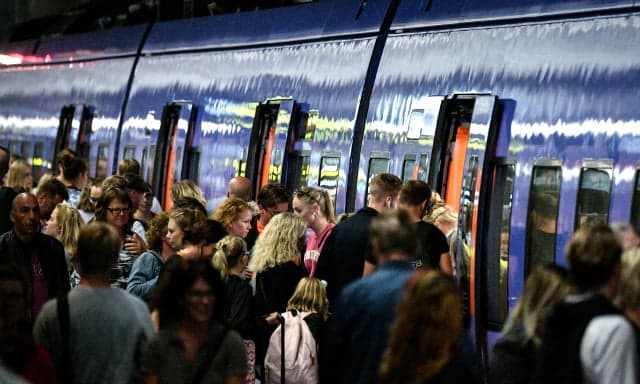Here's how many trains ran on time in Sweden last year

You will never believe this, but slightly more trains arrived on time in Sweden last year than the year before. But perhaps we're setting the standards low.
Sticklers for punctuality may disagree, but Sweden's state-run agency Transport Analysis (Trafikanalys) considers a train to have arrived "on time" if it pulled in at the station less than five minutes behind schedule.
A total of 90.3 percent of all trains thus arrived on time in 2017, a slight increase of 0.2 percentage units compared to 2016 and not a massive change on the past five years.
If you are less accommodating when it comes to punctuality, you might prefer to say that 66 percent of trains arrived on time last year. That figure does not treat those that arrived 1-5 minutes behind schedule as "on time".
In total, trains were delayed by 47,000 hours last year (up from 45,000 hours in 2016).
However, on average trains were delayed by three minutes (eight minutes if you only count those that were actually late) – a figure that remarkably has remained stable in the past five years.
Not all trains are created equal. Long-distance trains arrived on schedule 78 percent of the time. Short-distance trains (including commuter trains) were more reliable: 93 percent were less than five minutes late.
Only 1.7 percent of scheduled trains were cancelled, according to Transport Analysis.
Rail traffic increased from 852,000 to 965,000 trains between 2013 and 2017. Sweden's railways have been a hot debate topic in recent years, with a lack of maintenance often blamed for delays. The government has allocated more money to upgrading tracks, some of which have been in use for 150 years.
Another contributing factor is said to be that Sweden's high-speed trains run on the same tracks as local and freight trains, which means that small delays can quickly become bigger if a high-speed train is stuck behind a slow one.
READ ALSO:
Comments
See Also
Sticklers for punctuality may disagree, but Sweden's state-run agency Transport Analysis (Trafikanalys) considers a train to have arrived "on time" if it pulled in at the station less than five minutes behind schedule.
A total of 90.3 percent of all trains thus arrived on time in 2017, a slight increase of 0.2 percentage units compared to 2016 and not a massive change on the past five years.
If you are less accommodating when it comes to punctuality, you might prefer to say that 66 percent of trains arrived on time last year. That figure does not treat those that arrived 1-5 minutes behind schedule as "on time".
In total, trains were delayed by 47,000 hours last year (up from 45,000 hours in 2016).
However, on average trains were delayed by three minutes (eight minutes if you only count those that were actually late) – a figure that remarkably has remained stable in the past five years.
Not all trains are created equal. Long-distance trains arrived on schedule 78 percent of the time. Short-distance trains (including commuter trains) were more reliable: 93 percent were less than five minutes late.
Only 1.7 percent of scheduled trains were cancelled, according to Transport Analysis.
Rail traffic increased from 852,000 to 965,000 trains between 2013 and 2017. Sweden's railways have been a hot debate topic in recent years, with a lack of maintenance often blamed for delays. The government has allocated more money to upgrading tracks, some of which have been in use for 150 years.
Another contributing factor is said to be that Sweden's high-speed trains run on the same tracks as local and freight trains, which means that small delays can quickly become bigger if a high-speed train is stuck behind a slow one.
READ ALSO:
Join the conversation in our comments section below. Share your own views and experience and if you have a question or suggestion for our journalists then email us at [email protected].
Please keep comments civil, constructive and on topic – and make sure to read our terms of use before getting involved.
Please log in here to leave a comment.